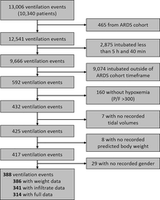
A quantitative approach for the analysis of clinician recognition of acute respiratory distress syndrome using electronic health record data
Abstract
__Importance__ Despite its efficacy, low tidal volume ventilation (LTVV) remains severely underutilized for patients with acute respiratory distress syndrome (ARDS). Physician under-recognition of ARDS is a significant barrier to LTVV use. We propose a computational method that addresses some of the limitations of the current approaches to automated measurement of whether ARDS is recognized by physicians. __Objective__ To quantify patient and physician factors affecting physicians’ tidal volume selection and to build a computational model of physician recognition of ARDS that accounts for these factors. __Design, setting, and participants__ In this cross-sectional study, electronic health record data were collected for 361 ARDS patients and 388 non-ARDS hypoxemic (control) patients in nine adult intensive care units at four hospitals between June 24 and December 31, 2013. __Methods__ Standardized tidal volumes (mL/kg predicted body weight) were chosen as a proxy for physician decision-making behavior. Using data-science approaches, we quantified the effect of eight factors (six severity of illness, two physician behaviors) on selected standardized tidal volumes in ARDS and control patients. Significant factors were incorporated in computational behavioral models of physician recognition of ARDS. __Results__ Hypoxemia severity and ARDS documentation in physicians’ notes were associated with lower standardized tidal volumes in the ARDS cohort. Greater patient height was associated with lower standardized tidal volumes (which is already normalized for height) in both ARDS and control patients. The recognition model yielded a mean (99% confidence interval) physician recognition of ARDS of 22% (9%-42%) for mild, 34% (19%-49%) for moderate, and 67% (41%-100%) for severe ARDS. __Conclusions and relevance__ In this study, patient characteristics and physician behaviors were demonstrated to be associated with differences in ventilator management in both ARDS and control patients. Our model of physician ARDS recognition measurement accounts for these clinical variables, providing an electronic approach that moves beyond relying on chart documentation or resource intensive approaches.